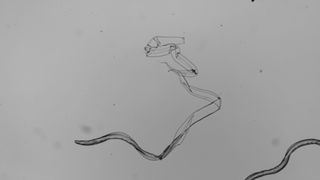'American Murderer' Worm Strips To Evade Your Immune System
A new study finds that the killer, the parasitic hookworm Necator americanus — nicknamed the "American Murderer" — may slither out of its skin to evade the immune systems of an estimated 700 million infected people around the world. (The worm earned its alias because it's commonly found in the soil of the southern United States and much of South America.)
Researchers captured footage of the young hookworms shedding their larval sheaths (similar to how an insect might molt its skin) when exposed to conditions that mimic the environment of a human body. Then, using advanced scanning techniques, the researchers determined that these discarded sheaths have a distinct chemical signature compared with the body of the wormand may be used as a decoy to distract the immune systems of unwary hosts. [The 10 Most Diabolical and Disgusting Parasites]
"We think this particular organism is able to penetrate the body, hide itself within this cloak or sheath and, at the right moment, expel [from the sheath] and find it’s way toward the intestinal tract," said lead study author Veeren Chauhan, a research fellow at the University of Nottingham School of Pharmacy. "It does that by depositing this sheath as a sort of distraction. It's a good decoy."

Catching a silent killer
N. Americanus thrives in tropical and subtropical soil around the world, and has a knack for squirming into human (and some animal) skin when bare feet come into contact with contaminated soil, according to the study, published yesterday (Dec. 7) in the journal PLOS Neglected Tropical Diseases. After entering a host's body and shedding its sheath, the worm travels through the bloodstream through the heart, into the lungs and past the stomach before eventually settling into the intestines, where it can grow and reproduce, without being detected, for up to 15 years.
Serious symptoms of hookworm infection — such as anemia, fatigue, fever, nausea, vomiting and abdominal pain that can lead to long-term disability or death — tend to appear only after hundreds of worms infect a single host. Chauhan and his team hypothesized that the worm's sheath-shedding behavior might hold the key to its ability to dodge detection for so many years.
Using N. Americanus specimens collected in Papua New Guinea and cultivated at the lab in Nottingham, England, the researchers closely examined the worm's cloak-shedding process, which is known as "exsheathment." The team used a scanning technique called atomic force microscopy to create a nanometer-scale map comparing the physical features of the worm's sheath to its body.
Sign up for the Live Science daily newsletter now
Get the world’s most fascinating discoveries delivered straight to your inbox.
"We found that the sheath is highly textured, and a lot stickier in comparison to the worm body once it molts," Chauhan said. That likely makes it easier for the sheath to attract the attention of the host body. "This brought up some interesting questions," he added.
Next, the researchers used a technique called time-of-flight secondary ion mass spectrometry, which "bombarded the surface" of the worm with molecules to remove the first layer of the chemical surface, allowing the researchers to analyze its properties. They found that the sheath contained a number of "immunologically active" molecules that the body of the worm did not have, suggesting that the sheath may be more likely to trigger a human immune response while the worm wriggled away. [8 Awful Parasite Infections That Will Make Your Skin Crawl]
Although more research is needed to understand the full biological significance of the worm's sheath-shedding modus operandi, Chauhan said he likens his team's findings to capturing the first "fingerprint" of an elusive killer.
"Forensics-wise, if you identify a criminal’s fingerprint, you're looking at the [physical] surface of it; if you're lucky, you might get a chemical signature," Chauhan said. "We've identified new properties about this pathogen that infects close to 10 percent of the global population, and it could hopefully lead to the development of therapeutics, or finding a mechanism whereby this infection could be stopped before it even gets to the body."
An effective vaccine for hookworm disease has yet to be developed, though research is ongoing. Chauhan said he believes his team's findings, and their novel methods of analyzing the worm, "pave the way forward" for future success in the field.
Originally published on Live Science.

Brandon is the space/physics editor at Live Science. His writing has appeared in The Washington Post, Reader's Digest, CBS.com, the Richard Dawkins Foundation website and other outlets. He holds a bachelor's degree in creative writing from the University of Arizona, with minors in journalism and media arts. He enjoys writing most about space, geoscience and the mysteries of the universe.

